Upgrading
Project GTI to
Improved Touring B Class
Spring 2004 |
The
SCCA Improved Touring category is divided into four classes. The 1993-1997
Golfs (including the GTI with the 2.0 four-cylinder engine) are listed
in ITB. This category allows substantial stripping of the car and bolt-on
modifications to improve lap times.
It
has always been in the plan to upgrade the PhilsTireService.com
Team GTI VW to the IT rules but the timeline has been pushed up in order
to enter the car in IT for the Charge of the Headlight Brigade
13-hour endurance race at Virginia International Raceway, October 23rd,
2004. The safety equipment rules are identical so we can concentrate on
upgrading performance.
Importantly,
while the GTI is not typically considered to be a contender in SSC, it
is commonly believed that it will be a competitive ITB car...
|
The first and simplest
upgrade from Showroom Stock to IT specification is the tires. The SS
rules restrict tire width to an increase of not more than +20 beyond
what came originally came on the car and aspect ratio to a decrease
of not more than 10. In SS trim, Project GTI sat on 205/55-14 fully
treaded Toyo Proxes RA-1 tires from PhilsTireService.com
- seen here on the right.
Under IT rules,
any tire that will fit on a 6" wide wheel of the original diameter
may be used, providing that it fits under the stock fender profile.
The original equipment 14x6 alloy wheels will still be used but will
now be shod with whopping great 225/50-14 Toyos (on the left in the
picture).
These new meats
are approximately 3/4" wider than the 205s - although almost the
same overall diameter - and have been shaved to a tread depth of approximately
4/32", to put more tread surface on the track to improve performance.
This process can
also reduce heat build-up in the rubber that can lead to blistering
or chunking of the tread, even though this hasn't been a problem with
the full-tread Toyos. The treaded 205s are not obsolete, however: They
will be used in the event of rain.
|
|
If
there is any doubt about why we are looking forward to upgrading the suspension
on Project GTI, this picture should put it to rest.
In Showroom Stock
form, soft springs and a lack of roll control result in massive weight
transfer to the outside tires - particularly the outside front, which
ends up being severely overworked. The car is not as fast as it might
be and the tires don't last as long as they would, were the suspension
optimized for racing.
The KONI
Improved Touring suspension will flatten the car out in the corners
and put all four tires to work holding the car on line. |

Shoot
to Thrill Photos |
| The
13-hour endurance crew is introduced to the fans.
During the upgrade,
we will continue to document Project GTI in action
but check in here regularly to see what has changed as we prepare for
more than half a day of high-speed fun. |
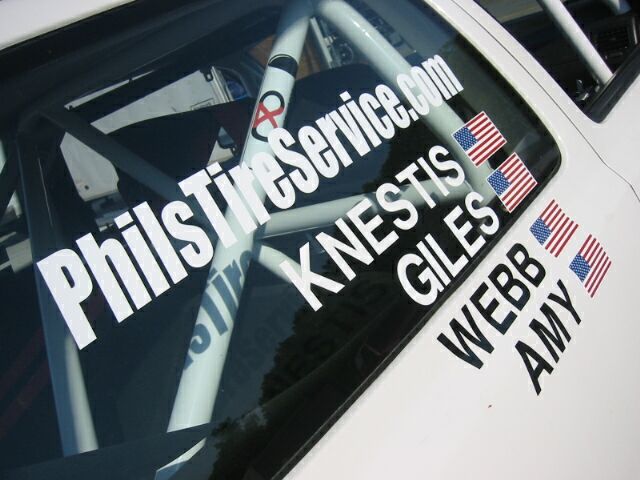 |
| Perhaps
the most obvious change to Project GTI during the upgrade to IT rules
is the removal of the stock interior. The regulations allow removal of
essentially all of the carpet, seats, interior panels, headliner, and
trim. The dashboard must remain as stock, however.
We elected to retain
the door panels as they afford some measure of crushable structure between
the driver and the outside world, and because we are leaving the door
glass winder mechanisms functional for rally and rallycross competition.
The insulating tar
was also removed from much of the passenger compartment floor - a miserable
job that is almost a rite of passage for anyone building a stock-bodied
racing car.

Before
|
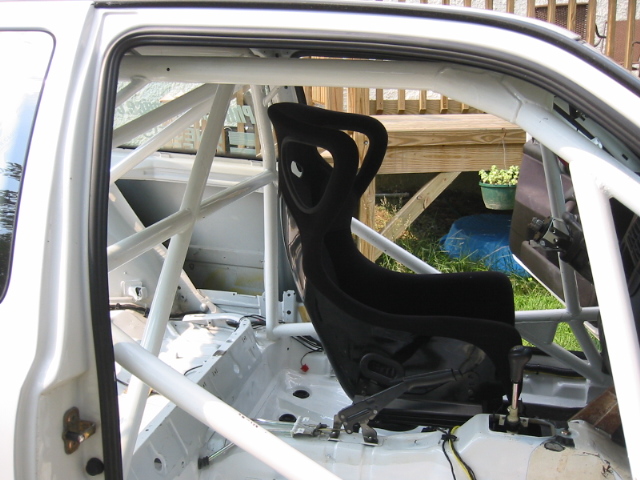 |
| Evidence
of the interior stripping effort is equally striking from the view looking
in the rear hatch. While it is legal to remove the seats, it is not permissible
to remove any of the brackets that support them.
At the time of construction,
it was unclear how much weight Project GTI lost on its diet. The minimum
weight for the Mk III Golf in ITB trim is 2350 pounds - 330 pounds less
than the minimum in Showroom Stock C (including the driver). It is optimistic
to believe that we are likely to make that weight at our current conservative
level of preparation.

Before
|
 |
| 1/4-inch
stainless steel mesh has been added to all front grill openings, to protect
the radiator from rocks or other debris that might damage it.
It is legal to run
an air dam in Improved Touring but we will stick with the stock lip for
the time being. |
 |
| A
number of minor but significant improvements have been made to the cockpit
of Project GTI, to enhance safety and control.
A master electrical
switch (the red handle in the picture to the right) is accessible from
the driver's seat and from outside the car, through the open side window.
It shuts off the engine and isolates the battery in the event that emergency
response becomes necessary.
The LTB
Motorsports quick-release steering wheel hub creates more room for
driver changes while also moving the wheel farther toward the rear of
the car, affording better wheel placement relative to the shifter and
pedals.
The textured aluminum
pedal pads (also from LTB
Motorsports) are firmly screwed to the throttle, brake, and clutch
to provide extra grip and to facilitate heel-and-toe downshifting. This
technique allows the driver to slow for a corner while simultaneously
matching engine revs to the car's speed for downshifts, by pushing on
both the brake and throttle with the right foot. |
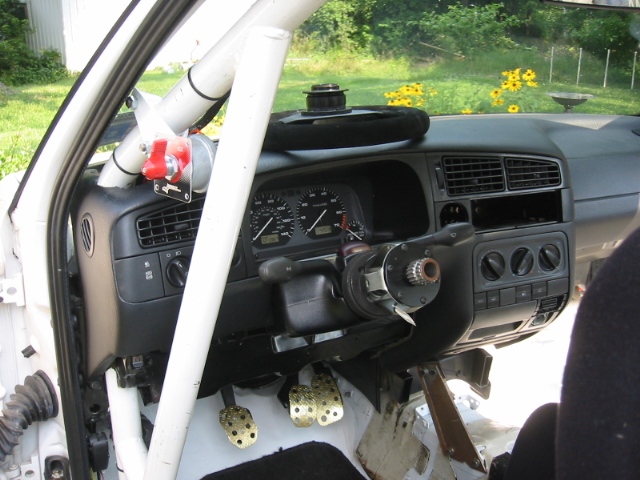 |
| The
struts are relatively simple single-adjustable
KONI Sports (commonly referred to as "Yellows") on all four
corners, specially valved by KONI's North American race shop to accommodate
500# front and 450# rear springs.
Ride heights are fully
adjustable thanks to threaded sleeves on the strut units, and assembly
was actually easier than with original equipment parts - no spring compressor
needed.
A large-diameter rear
anti-roll bar (ARB) was also installed and the stock front bar will be
removed, to replace the safe-but-slow understeer of the stock VW with
an appropriate amount of oversteer - that is faster but requires quick
hands to manage.

|
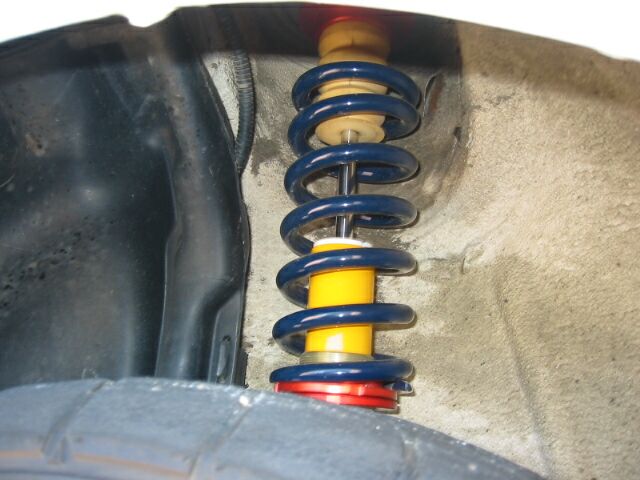 |
| You
immediately notice the change in stance of the Mk III GTI with the KONI
suspension installed. It actually looks a little bit like a racing car
now.
The front end of the
car is actually still a little too low, given common wisdom about the
impact of lower control arm inclination on the roll centers of the MacPherson
strut front suspension on these cars. The fastest Mk II VWs running in
ITB tend to look nose-high for this reason and additional testing will
determine where the settings on the Phil's Tire Service GTI end up.
The track scales at
Virginia International Raceway also confirmed that our "diet"
netted a 125-pound loss through the removal of seats and interior. Decreased
mass makes a race car faster everywhere on the track - on the throttle,
braking, and cornering. |
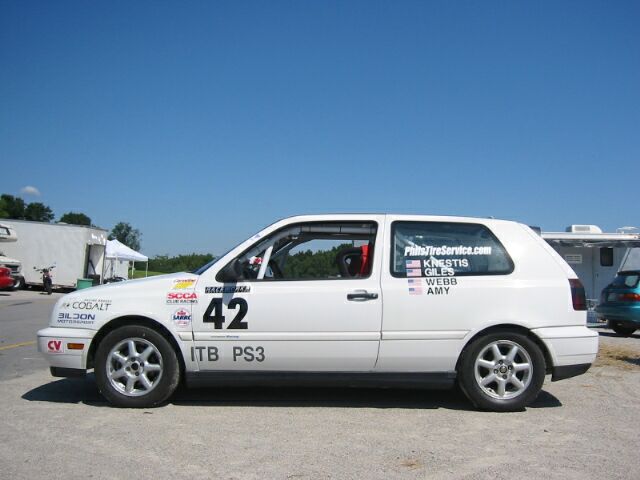 |
| The
impact of the suspension installation is dramatic once on the track. The
car corners flatter and the rear tires are now on the ground, contributing
to the grip-generating effort.
In SSC form, the Golf
wanted to go straight rather than change direction quickly - a condition
known as understeer. The front tires were operating at large steering
angles, relative to the direction the driver wanted to go, overworking
the tires and slowing the car down.
With the new suspension,
the Golf changes direction much more quickly, allowing the driver to get
onto the throttle sooner for faster corner exit speeds. Having four tire
contact patches improves entry and mid-corner speed as well.

Before
|
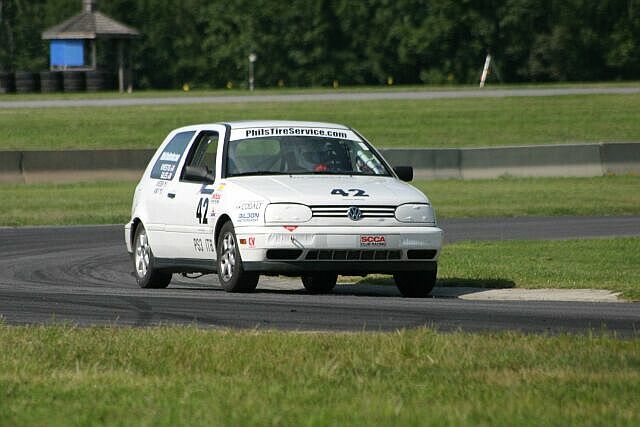
F&S Enterprises Photo |
| The
ITB designation is finally on the doors.
An interesting technical
note - these are the 205/55-14 fully treaded Toyo Proxes RA-1 tires purchased
from PhilsTireService.com
at the beginning of the season.
With attention and
careful rotation, they have survived an estimated 9 hours of track time
and as they get "old" and the tread blocks wear away, they just
seem to get faster and more predictable. Surprisingly, heat cycles don't
seem to have any negative impact on their behavior. |
 |
| Light
alloy quick-release hood pins, also from LTB
Motorsports, replace the stock interior and safety catch hood release.
This allows the crew to get to the engine compartment quickly during pit
stops, and saves a little weight at the same time.
It should be noted
that one measures more than twice before drilling 1/2" diameter holes
in a perfectly good hood. |
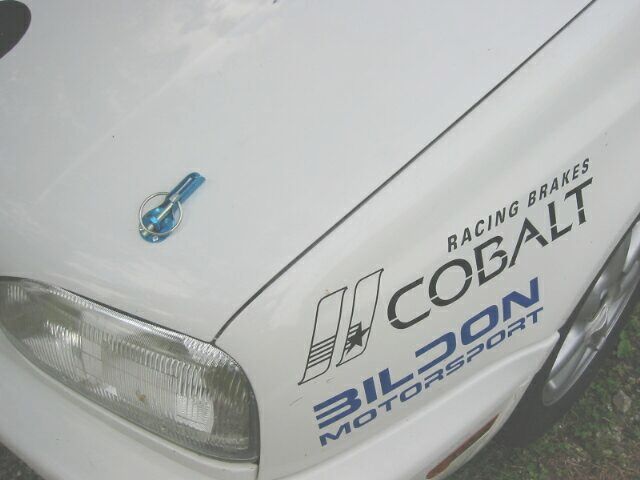 |
|
The long wheel studs and lug nuts from Bildon
Motorsports will make pit stops quicker and safer. These allow the
mechanics to positively locate the wheel rather than trying to line up
the difficult lug bolts that come on VW products. The extra length makes
it easy to start the nuts, a second cool set of which will be provided
for the tire changer at each corner, since the ones coming off of the
car will be heated to several hundred degrees by the brakes.
These studs require
the use of a wheel spacer of at least 5mm thickness with stock VW alloy
wheels. This pushes the wider 225/50-14 Toyos out closer to the edge of
the fenders - the rear, in this case. |
 |
| Among
the improvements tailored specifically for the unusual demands of the
13-hour enduro in October are reflective number panels.
Made of a white reflective
vinyl - similar to that used on street signs - the rectangles are essentially
invisible during the daylight hours but pop to life when light hits them
at night. |
 |
| This
was a busy week that started with the team's lead VW technician, Cameron
Conover of import auto specialist der
Wagen Haus (Greensboro, NC) putting in some overtime. Conover replaced
the front suspension uprights, hubs, bearings, and steering tie rods with
more parts out of Bildon
Motorsports stock. None of these parts were worn out but were replaced
in the interest of absolute reliability for the upcoming endurance race.
The parts that came off will serve as spares for the event.
Project GTI then went
back to Chris Schimmel at Competition
Cages for a new seat mounting system and new brackets for the window
net.
The original seat
mount was a sliding frame assembly that rode in the stock guides. It would
have been perfect for street use but was both too high and too heavy for
racing. Schimmel fabricated a tubular frame welded to the tunnel and inside
rocker panel, to which were bolted aftermarket sliding rails, aluminum
side brackets (replacing heavier steel versions), and a Recaro seat that
will accommodate drivers of different sizes for the enduro.
While that work was
going on, the last of the interior floor sound insulation was removed
and the front half of the passenger compartment was repainted. |
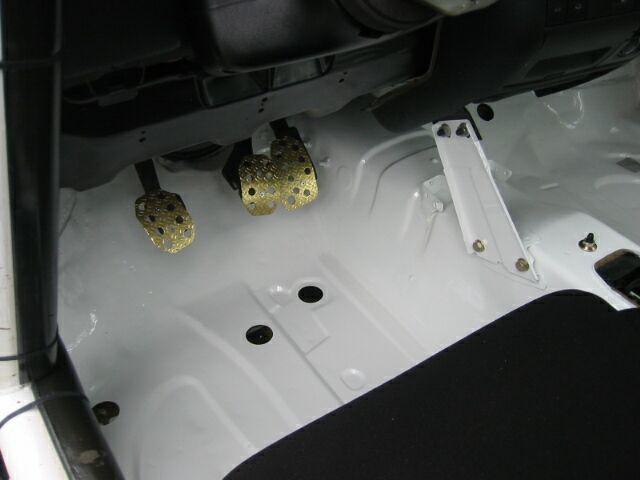 |
This
light pod from the vastly experienced Northwest VW rally team Hartmann
Motorsport mounts four 100 watt driving lights, to make it possible to
run flat-out after dark during the VIR 13-hour enduro.
The system mounts
with two 1/4 turn fasteners, a locating pin in the front of the hood,
tabs on top of the radiator support, and two electrical plugs, allowing
the crew to install it quickly during a fuel stop. |
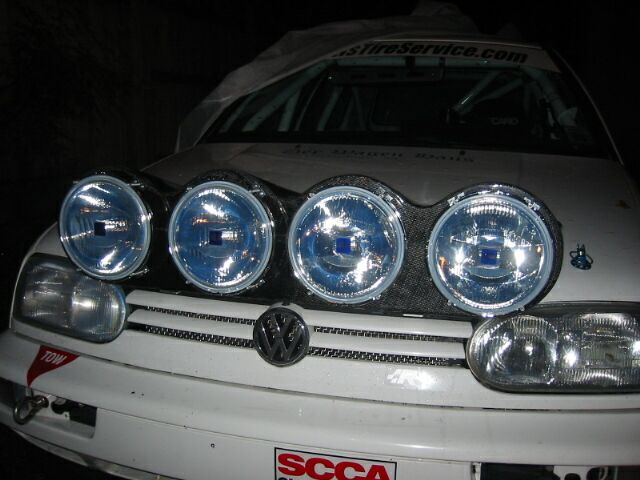 |
Improved
Touring rules require that the glass moonroof that comes in almost all
MkIII GTIs be removed and the hole covered by a piece of sheet steel at
least as thick as the stock roof.
We had a piece of
sheetmetal cut to the necessary size and shape, and punched with 1/8"
holes around the periphery by a local roofing shop. This was installed
with steel pop rivets and sealant and painted black to replicate the look
of the original tinted glass panel. |
 |
|
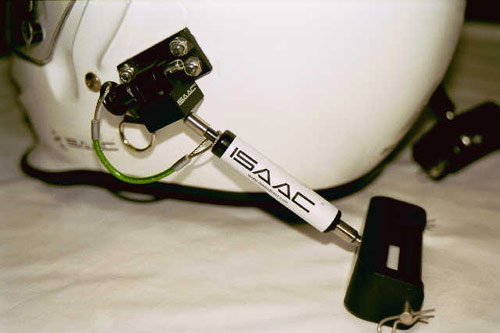
Isaac, LLC Photo
|
| PhilsTireService.com
Team GTI takes class victory at the VIR 13-hour enduro! |
All
of our hard work updating the Golf to ITB specifications and preparing
it for the rigors of a long race paid off on October 23rd, when Greg Amy,
Evan Webb, Scott Giles, Kirk Knestis, and a team of talented volunteers
took home a class victory in the Charge of the
Headlight Brigade 13 Hour enduro.
The car wasn't even
cooled down when the team started planning for next year, including lively
discussion about which mechanical updates should happen next. Stay
tuned here for Phase III of Project GTI, as additional tweaks are
considered, planned, and executed:
>>
Transmission
- lower final drive, limited slip differential, maintenance rebuild, and
ring-gear bolt kit
>>
Engine - IT-spec
rebuild with raised compression, replacement of service parts, and optimization
of internal parts (balancing and blueprinting)
>>
Intake and
Exhaust - street-legal exhaust system with muffler and race-spec catalytic
converter, optimized engine management chip
>>
Suspension
- additional adjustable rear antiroll bar, revised spring rates and alignment,
wheel spacers, and camber plates
>>
Cockpit - upgraded
instrumentation, improved mirrors, and a driver's footwell plate with
dead pedal rest
>>
Brakes - removal
of all ABS system hardware, replumbing of hard lines, and addition of
a balance proportioning valve |
| Last
updated 1 January, 2005
All photos Kirk Knestis unless otherwise noted |
Project
GTI is headquartered in Greensboro, NC |






















